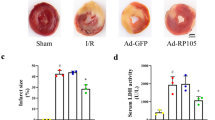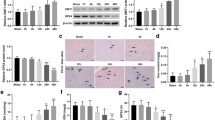Abstract
The protective effect and mechanism of isoflurane on myocardial injury was investigated by constructing in vitro hypoxia/reoxygenation (HR) cell model. HR cell models were established in vitro and treated with isoflurane (ISO). qRT-PCR was used to detect the relative expression of miR-18a-5p. CCK-8 kit and flow cytometry were performed to evaluate cell proliferation and apoptosis. The myocardial injury related markers, such as Cκ-MB, cTnI and LDH were detected by ELISA. Luciferase reporter gene assay was used to verify the interaction between miR-18a-5p and target genes. The expression of miR-18a-5p was significantly increased in hypoxic cardiomyocytes compared with control group (P < 0.001). Meanwhile, cardiomyocytes in the HR group showed inhibition of proliferation, a significant increase in cell apoptosis and in myocardial injury indicators, such as Cκ-MB, cTnI and LDH (P < 0.001). However, 1% ISO treatment alleviated myocardial cell injury induced by HR. Transfection of miR-18a-5p under ISO reduced the protective effect of 1% ISO against myocardial cell damage. Luciferase report gene assay confirmed that CCND2 might be the target gene of miR-18a-5p. In the in vitro cell model of myocardium, ISO alleviated cardiomyocyte injury caused by hypoxia/reoxygenation by down-regulating the expression of miR-18a-5p.




Similar content being viewed by others
References
Binder, A., Ali, A., Chawla, R., Aziz, H. A., Abbate, A., & Jovin, I. S. (2015). Myocardial protection from ischemia-reperfusion injury post coronary revascularization. Expert Review of Cardiovascular Therapy, 13, 1045–1057.
Mokhtari-Zaer, A., Marefati, N., Atkin, S. L., Butler, A. E., & Sahebkar, A. (2018). The protective role of curcumin in myocardial ischemia-reperfusion injury. Journal of Cellular Physiology, 234, 214–222.
Zorov, D. B., Juhaszova, M., & Sollott, S. J. (2014). Mitochondrial reactive oxygen species (ROS) and ROS-induced ROS release. Physiological Reviews, 94, 909–950.
Ovize, M., Baxter, G. F., Di Lisa, F., Ferdinandy, P., Garcia-Dorado, D., Hausenloy, D. J., et al. (2010). Postconditioning and protection from reperfusion injury: Where do we stand? Position paper from the Working Group of Cellular Biology of the Heart of the European Society of Cardiology. Cardiovascular Research, 87, 406–423.
Wojciechowska, A., Braniewska, A., & Kozar-Kaminska, K. (2017). MicroRNA in cardiovascular biology and disease. Advances in Clinical and Experimental Medicine, 26, 865–874.
Hata, A. (2013). Functions of microRNAs in cardiovascular biology and disease. Annual Review of Physiology, 75, 69–93.
Condorelli, G., Latronico, M. V., & Cavarretta, E. (2014). microRNAs in cardiovascular diseases: Current knowledge and the road ahead. Journal of the American College of Cardiology, 63, 2177–2187.
Quiat, D., & Olson, E. N. (2013). MicroRNAs in cardiovascular disease: From pathogenesis to prevention and treatment. The Journal of Clinical Investigation, 123, 11–18.
Liu, Y., Yang, L., Yin, J., Su, D., Pan, Z., Li, P., et al. (2018). MicroRNA-15b deteriorates hypoxia/reoxygenation-induced cardiomyocyte apoptosis by downregulating Bcl-2 and MAPK3. Journal of Investigative Medicine, 66, 39–45.
Zhang, Y., & Chen, X. (2020). miR-18a-5p promotes proliferation and migration of vascular smooth muscle cells by activating the AKT/extracellular regulated protein kinases (ERK) signaling pathway. Medical Science Monitor, 26, e924625.
Lin, B., Feng, D., & Xu, J. (2019). Cardioprotective effects of microRNA-18a on acute myocardial infarction by promoting cardiomyocyte autophagy and suppressing cellular senescence via brain derived neurotrophic factor. Cell & Bioscience, 9, 38.
Ferreira, R., Santos, T., Amar, A., Gong, A., Chen, T. C., Tahara, S. M., et al. (2014). Argonaute-2 promotes miR-18a entry in human brain endothelial cells. Journal of the American Heart Association, 3, e000968.
Zhou, Y., Peng, D. D., Chong, H., Zheng, S. Q., Zhu, F., & Wang, G. (2019). Effect of isoflurane on myocardial ischemia-reperfusion injury through the p38 MAPK signaling pathway. European Review for Medical and Pharmacological Sciences, 23, 1342–1349.
Pi, Z., Lin, H., & Yang, J. (2018). Isoflurane reduces pain and inhibits apoptosis of myocardial cells through the phosphoinositide 3-kinase/protein kinase B signaling pathway in mice during cardiac surgery. Molecular Medicine Reports, 17, 6497–6505.
Yang, L., Wu, J., Xie, P., Yu, J., Li, X., Wang, J., et al. (2019). Sevoflurane postconditioning alleviates hypoxia-reoxygenation injury of cardiomyocytes by promoting mitochondrial autophagy through the HIF-1/BNIP3 signaling pathway. PeerJ, 7, e7165.
Yellon, D. M., & Hausenloy, D. J. (2007). Myocardial reperfusion injury. New England Journal of Medicine, 357, 1121–1135.
Eltzschig, H. K., & Eckle, T. (2011). Ischemia and reperfusion–from mechanism to translation. Nature Medicine, 17, 1391–1401.
Granger, D. N., & Kvietys, P. R. (2015). Reperfusion injury and reactive oxygen species: The evolution of a concept. Redox Biology, 6, 524–551.
Law, C. H., Li, J. M., Chou, H. C., Chen, Y. H., & Chan, H. L. (2013). Hyaluronic acid-dependent protection in H9C2 cardiomyocytes: A cell model of heart ischemia-reperfusion injury and treatment. Toxicology, 303, 54–71.
Tsutsumi, Y. M., Patel, H. H., Lai, N. C., Takahashi, T., Head, B. P., & Roth, D. M. (2006). Isoflurane produces sustained cardiac protection after ischemia-reperfusion injury in mice. Anesthesiology, 104, 495–502.
Qiao, S., Olson, J. M., Paterson, M., Yan, Y., Zaja, I., Liu, Y., et al. (2015). MicroRNA-21 mediates isoflurane-induced cardioprotection against ischemia-reperfusion injury via Akt/Nitric oxide synthase/mitochondrial permeability transition pore pathway. Anesthesiology, 123, 786–798.
Liu, H. J., & Liu, B. (2018). Inhibition of microRNA-23 contributes to the isoflurane-mediated cardioprotection against oxidative stress. Cardiovascular Toxicology, 18, 450–458.
Wu, W., Zhou, X., Liu, P., Fei, W., Li, L., & Yun, H. (2014). Isoflurane reduces hypoxia/reoxygenation-induced apoptosis and mitochondrial permeability transition in rat primary cultured cardiocytes. BMC Anesthesiology, 14, 17.
Lang, X. E., Wang, X., Zhang, K. R., Lv, J. Y., Jin, J. H., & Li, Q. S. (2013). Isoflurane preconditioning confers cardioprotection by activation of ALDH2. PLoS ONE, 8, e52469.
Bauersachs, J., & Thum, T. (2011). Biogenesis and regulation of cardiovascular microRNAs. Circulation Research, 109, 334–347.
Li, R., Yan, G., Li, Q., Sun, H., Hu, Y., Sun, J., et al. (2012). MicroRNA-145 protects cardiomyocytes against hydrogen peroxide (H(2)O(2))-induced apoptosis through targeting the mitochondria apoptotic pathway. PLoS ONE, 7, e44907.
Ding, S., Liu, D., Wang, L., Wang, G., & Zhu, Y. (2020). Inhibiting microRNA-29a protects myocardial ischemia-reperfusion injury by targeting SIRT1 and suppressing oxidative stress and NLRP3-mediated pyroptosis pathway. Journal of Pharmacology and Experimental Therapeutics, 372, 128–135.
Jiang, M., Yin, Y., Xie, L., & He, H. (2018). Plasma miR-18 screens acute myocardial infarction from healthy controls by targeting hypoxia inducible factor 1alpha. Clinical Laboratory, 64, 1207–1212.
Cao, X., Wang, J., Wang, Z., Du, J., Yuan, X., Huang, W., et al. (2013). MicroRNA profiling during rat ventricular maturation: A role for miR-29a in regulating cardiomyocyte cell cycle re-entry. FEBS Letters, 587, 1548–1555.
Zhu, W., Zhao, M., Mattapally, S., Chen, S., & Zhang, J. (2018). CCND2 overexpression enhances the regenerative potency of human induced pluripotent stem cell-derived cardiomyocytes: remuscularization of injured ventricle. Circulation Research, 122, 88–96.
Funding
This work was supported by the National Natural Science Foundation of China (No. 81801193).
Author information
Authors and Affiliations
Contributions
GQ Chen and FQ Zhang conducted most of the experiments and drafted the manuscript. L Wang and ZG Feng designed this study, edited the manuscript and made the revision. Yujie Su and Xiangmei Gao revised the manuscript according to the comments of reviewers. All authors read and approved the final manuscript.
Corresponding authors
Ethics declarations
Conflict of interest
The authors declare that there are no conflict of interests.
Additional information
Handling Editor: Rajiv Janardhanan.
Publisher's Note
Springer Nature remains neutral with regard to jurisdictional claims in published maps and institutional affiliations.
Rights and permissions
About this article
Cite this article
Su, Y., Chen, G., Zhang, F. et al. Isoflurane Alleviates Myocardial Injury Induced by Hypoxia/Reoxygenation by Regulating miR-18a-5p. Cardiovasc Toxicol 21, 800–807 (2021). https://doi.org/10.1007/s12012-021-09670-1
Received:
Accepted:
Published:
Issue Date:
DOI: https://doi.org/10.1007/s12012-021-09670-1




